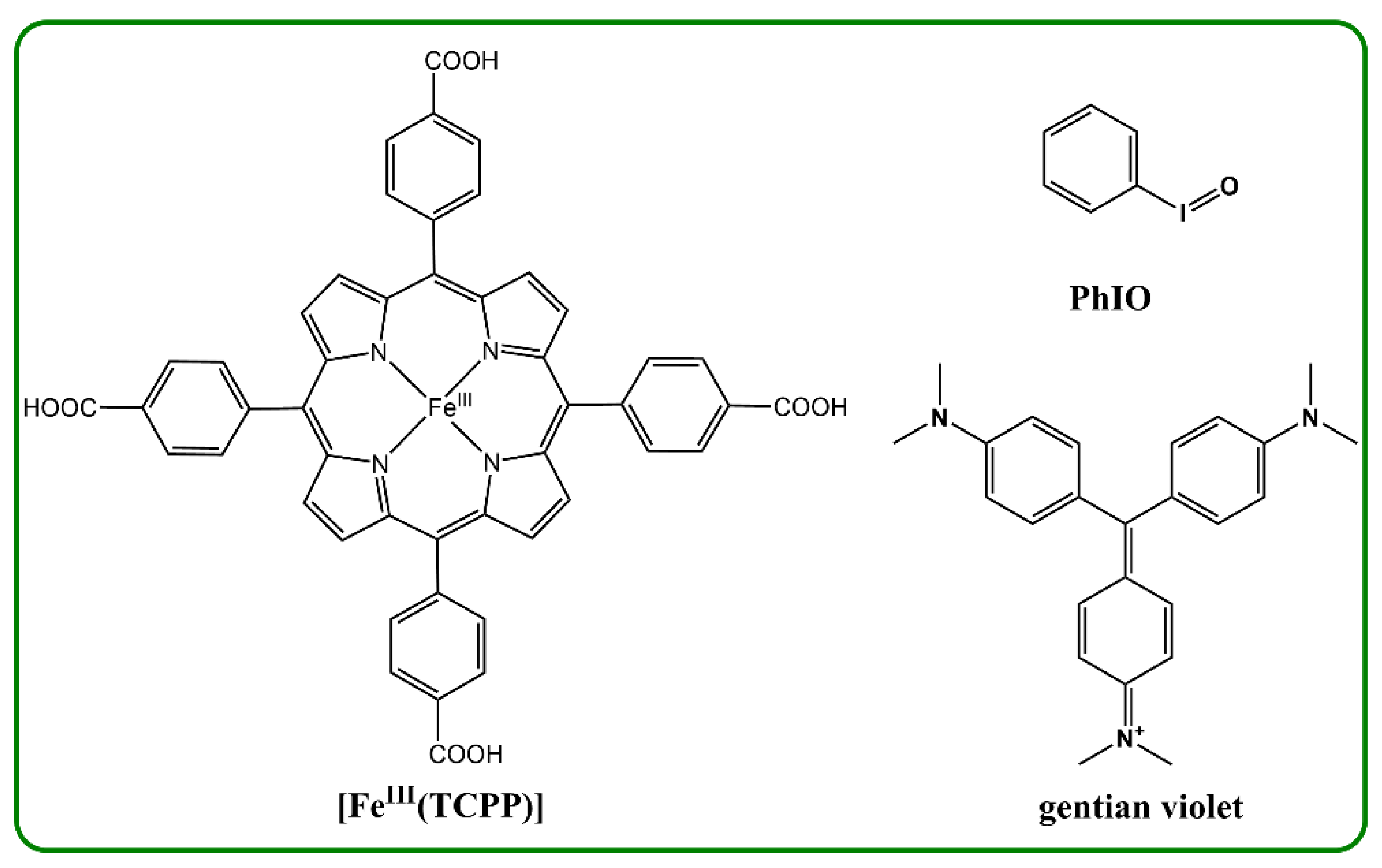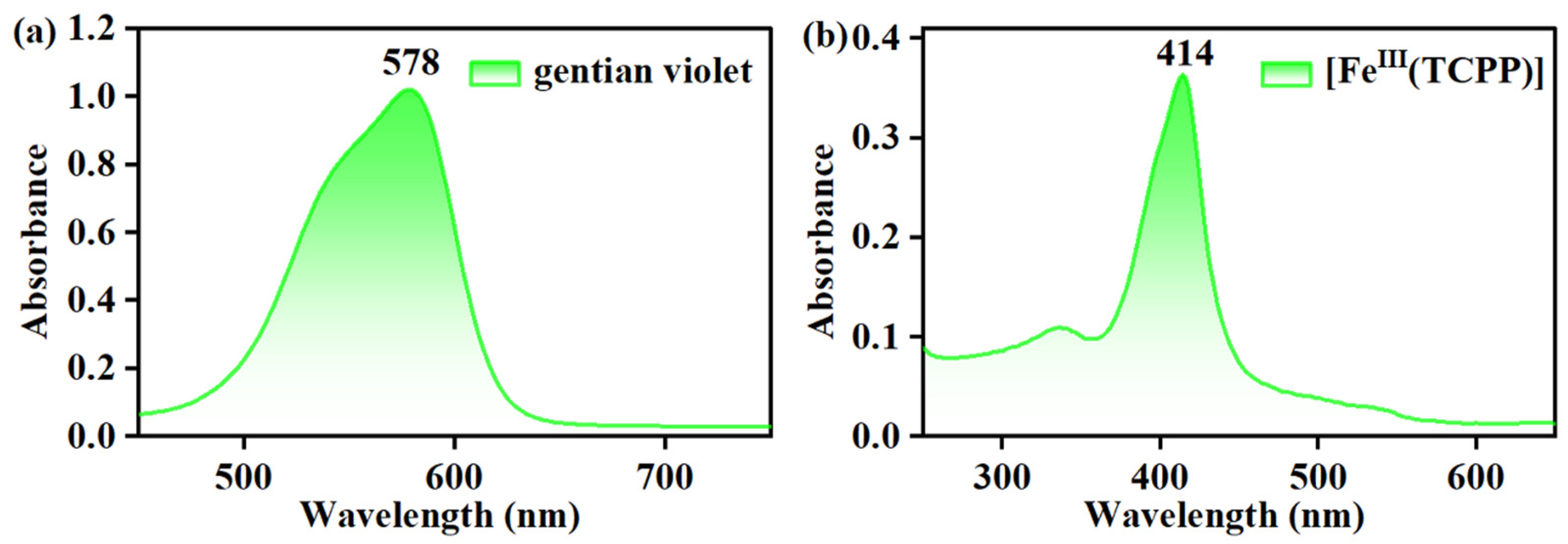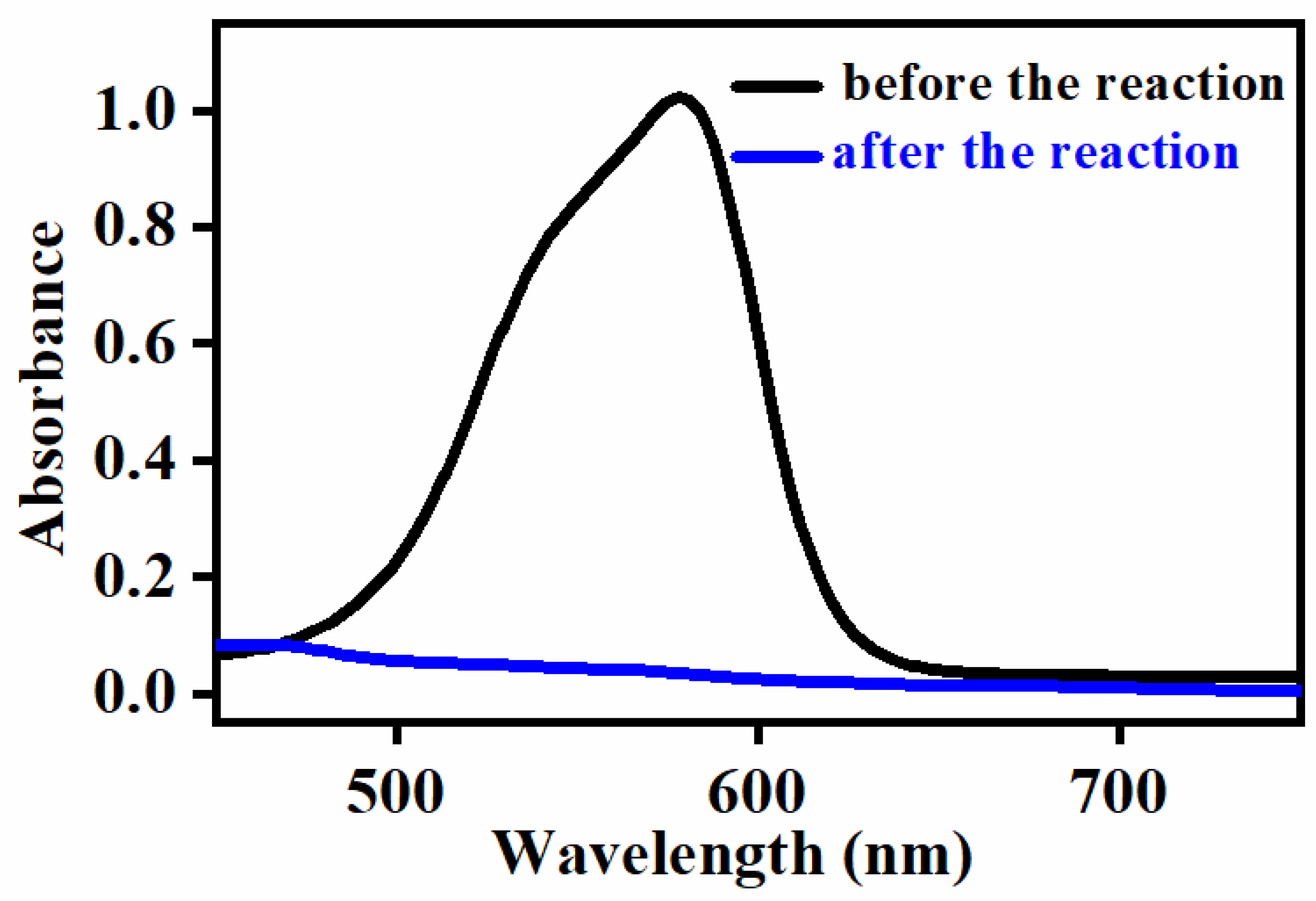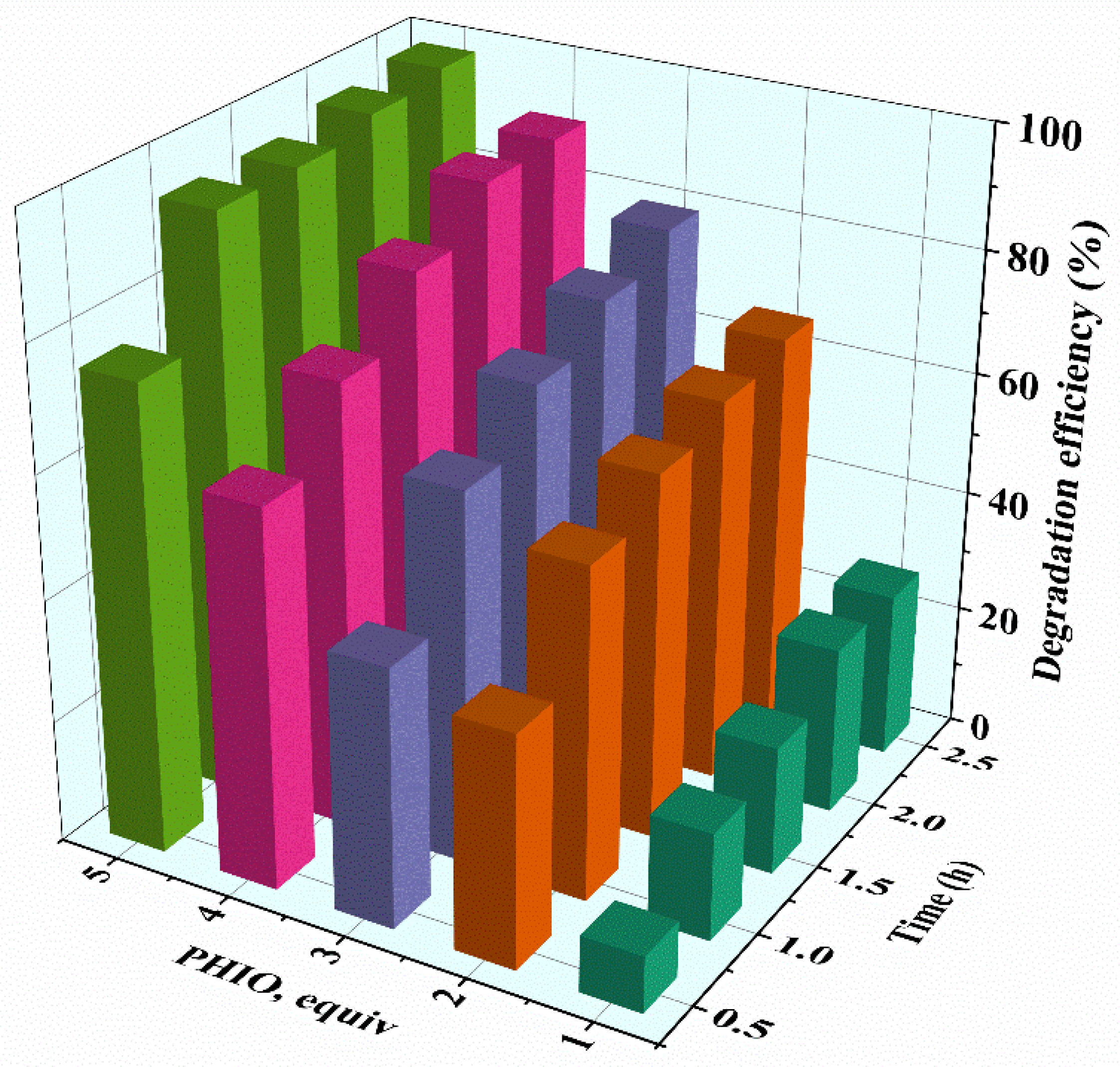Iron Porphyrin as a Cytochrome P450 Model for the Degradation of Dye
Abstract
1. Introduction
2. Materials and Methods
2.1. Materials and Instruments
2.2. Preparation of Iodosylbenzene (PhIO)
2.3. Determination of Concentration of Gentian Violet
2.4. Degradation of Gentian Violet
2.4.1. General Procedure for the Effect of PhIO Concentration on Degradation of Gentian Violet
2.4.2. General Procedure for the Effect of Reaction Time on Degradation of Gentian Violet
3. Results and Discussion
4. Conclusions
Supplementary Materials
Author Contributions
Funding
Institutional Review Board Statement
Informed Consent Statement
Data Availability Statement
Conflicts of Interest
References
- Reddy, P.A.K.; Reddy, P.V.L.; Kwon, E.; Kim, K.; Akter, T.; Kalagara, S. Recent advances in photocatalytic treatment of pollutants in aqueous media. Environ. Int. 2016, 91, 94–103. [Google Scholar] [CrossRef] [PubMed]
- Zhang, X.; Sun, R.; Sun, S.; Ren, F.; Chen, X.; Wu, L.; Xing, R. Metal-free organic optoelectronic molecule as a highly efficient photocatalyst for the degradation of organic pollutants. ACS Omega 2019, 4, 6068–6076. [Google Scholar] [CrossRef] [PubMed]
- Dapaah, M.F.; Niu, Q.; Yu, Y.; You, T.; Liu, B.; Cheng, L. Efficient persistent organic pollutant removal in water using MIL-metal-organic framework driven Fenton-like reactions: A critical review. Chem. Eng. J. 2022, 431, 134182. [Google Scholar] [CrossRef]
- Varjani, S.; Rakholiya, P.; Yong Ng, H.; You, S.; Teixeira, J.A. Microbial degradation of dyes: An overview. Bioresour. Technol. 2020, 314, 123728. [Google Scholar] [CrossRef] [PubMed]
- Azmi, W.; Sani, R.K.; Banerjee, U.C. Biodegradation of triphenylmethane dyes. Enzym. Microb. Technol. 1998, 22, 185–191. [Google Scholar] [CrossRef]
- Parshetti, G.; Parshetti, S.; Telke, A.; Kalyani, D.; Doong, R.; Govindwar, S.-P. Biodegradation of Crystal Violet by Agrobacterium radiobacter. J. Environ. Sci. 2011, 23, 1384–1393. [Google Scholar] [CrossRef]
- Alharbi, O.M.L.; Basheer, A.A.; Khattab, R.A.; Ali, I. Health and environmental effects of persistent organic pollutants. J. Mol. Liq. 2018, 263, 442–453. [Google Scholar] [CrossRef]
- Ember, E.; Rothbart, S.; Puchta, R.; van Eldik, R. Metal ion-catalyzed oxidative degradation of Orange II by H2O2. High catalytic activity of simple manganese salts. New J. Chem. 2009, 33, 34–49. [Google Scholar] [CrossRef]
- Shanker, U.; Rani, M.; Jassal, V. Degradation of hazardous organic dyes in water by nanomaterials. Environ. Chem. Lett. 2017, 15, 623–642. [Google Scholar] [CrossRef]
- Rothbart, S.; Ember, E.; van Eldik, R. Comparative study of the catalytic activity of [MnII(bpy)2Cl2] and [Mn2III/IV(μ-O)2(bpy)4] (ClO4)3 in the H2O2 induced oxidation of organic dyes in carbonate buffered aqueous solution. Dalton Trans. 2010, 39, 3264. [Google Scholar] [CrossRef]
- Nidheesh, P.V.; Zhou, M.; Oturan, M.A. An overview on the removal of synthetic dyes from water by electrochemical advanced oxidation processes. Chemosphere 2018, 197, 210–227. [Google Scholar] [CrossRef] [PubMed]
- Fu, H.-R.; Zhao, Y.; Xie, T.; Han, M.-L.; Ma, L.-F.; Zang, S.-Q. Stable dye-encapsulated indium–organic framework as dual-emitting sensor for the detection of Hg2+/Cr2O72− and a wide range of nitro-compounds. J. Mater. Chem. C 2018, 6, 6440–6448. [Google Scholar] [CrossRef]
- Fu, H.-R.; Yan, L.-B.; Wu, N.-T.; Ma, L.-F.; Zang, S.-Q. Dual-emission MOF⊃dye sensor for ratiometric fluorescence recognition of RDX and detection of a broad class of nitro-compounds. J. Mater. Chem. A 2018, 6, 9183. [Google Scholar] [CrossRef]
- Qin, J.-H.; Qin, W.-J.; Xiao, Z.; Yang, J.-K.; Wang, H.-R.; Yang, X.-G.; Li, D.-S.; Ma, L.-F. Efficient Energy-Transfer-Induced High Photoelectric Conversion in a Dye-Encapsulated Ionic Pyrene-Based Metal–Organic Framework. Inorg. Chem. 2021, 60, 18593–18597. [Google Scholar] [CrossRef] [PubMed]
- Yang, X.-G.; Qin, J.-H.; Huang, Y.-D.; Zhai, Z.-M.; Ma, L.-F.; Yan, D. Highly enhanced UV-vis-NIR light harvesting and photoelectric conversion of a pyrene MOF by encapsulation of the D–p–A cyanine dye. J. Mater. Chem. C 2020, 8, 17169–17175. [Google Scholar] [CrossRef]
- Wang, Y.; Wang, S.; Li, X.; Bai, P.; Yan, W.; Yu, J. Layered Inorganic Cationic Frame-works beyond Layered Double Hydroxides (LDHs): Structures and Applications. Eur. J. Inorg. Chem. 2020, 2020, 4055–4063. [Google Scholar] [CrossRef]
- Nguyen, T.L.; Dinh Quoc, V.; Nguyen, T.L.; Le, T.T.T.; Dinh, T.K.; Nguyen, V.T.; Nguyen, P.H. Visible-light-driven SO42-/TiO2 photocatalyst synthesized from Binh Dinh (Vietnam) ilmenite ore for Rhodamine B degradation. J. Nanomater. 2021, 2021, 1–13. [Google Scholar] [CrossRef]
- Kumar, A.P.; Bilehal, D.; Tadesse, A.; Kumarc, D. Photocatalytic degradation of organic dyes: Pd-γ-Al2O3 and PdO-γ-Al2O3 as potential photocatalysts. RSC Adv. 2021, 11, 6396. [Google Scholar] [CrossRef]
- Hariri, R.; Dehghanpour, S.; Sohrabi, S. Facile ultrasonic synthesis of zirconium based porphyrinic MOFs for enhanced adsorption performance towards anionic and mixed dye solutions. J. Inorg. Organomet. Polym. Mater. 2020, 30, 4720–4731. [Google Scholar] [CrossRef]
- Ahmed, M.B.; Zhou, J.L.; Ngo, H.H.; Guo, W.; Thomaidis, N.S.; Xu, J. Progress in the biological and chemical treatment technologies for emerging contaminant removal from wastewater: A critical review. J. Hazard. Mater. 2017, 323, 274–298. [Google Scholar] [CrossRef]
- Anis, S.F.; Lalia, B.S.; Lesimple, A.; Hashaikeh, R.; Hilal, N. Electrically conductive membranes for contemporaneous dye rejection and degradation. Chem. Eng. J. 2022, 428, 131184. [Google Scholar] [CrossRef]
- Yin, H.; Zhao, J.; Li, Y.Q.; Huang, L.L.; Zhang, H.; Chen, L.H. A novel Pd decorated Polydopamine-SiO2/PVA electrospun nanofiber membrane for highly efficient degradation of organic dyes and removal of organic chemicals and oils. J. Clean. Prod. 2020, 275, 122937. [Google Scholar] [CrossRef]
- Lopes, L.S.; Vieira, N.; da Luz, J.M.R.; Marliane de Cássia, S.S.; Cardoso, W.S.; Kasuya, M.C.M. Production of fungal enzymes in macaúba coconut and enzymatic degradation of textile dye. Biocatal. Agric. Biotechnol. 2020, 26, 101651. [Google Scholar] [CrossRef]
- Li, H.H.; Wang, Y.T.; Wang, Y.; Wang, H.X.; Sun, K.K.; Lu, Z.M. Bacterial degradation of anthraquinone dyes. J. Zhejiang Univ. Sci. B 2019, 20, 528–540. [Google Scholar] [CrossRef]
- Lan, J.; Chen, R.; Duo, F.; Hu, M.; Lu, X. Visible-Light Photocatalytic Reduction of Aryl Halides as a Source of Aryl Radicals. Molecules 2022, 27, 5364. [Google Scholar] [CrossRef]
- Li, T.-T.; Dang, L.-L.; Zhao, C.-C.; Lv, Z.-Y.; Yang, X.-G.; Zhao, Y.; Zhang, S.-H. A self-sensitized Co(II)-MOF for efficient visible-light-driven hydrogen evolution without additional cocatalysts. J. Solid State Chem. 2021, 304, 122609–122614. [Google Scholar] [CrossRef]
- Dang, L.-L.; Zhang, T.-T.; Li, T.-T.; Chen, T.; Zhao, Y.; Zhao, C.-C.; Ma, L.-F. Stable Zinc-Based Metal-Organic Framework Photocatalyst for Effective Visible-Light-Driven Hydrogen Production. Molecules 2022, 27, 1917. [Google Scholar] [CrossRef]
- Zhao, Y.; Wang, L.; Fan, N.-N.; Han, M.-L.; Yang, G.-P.; Ma, L.-F. Porous Zn(II)-Based Metal-Organic Frameworks Decorated With Carboxylate Groups Exhibiting High Gas Adsorption and Separation of Organic Dyes. Cryst. Growth Des. 2018, 18, 7114–7121. [Google Scholar] [CrossRef]
- Dang, L.-L.; Zong, D.-X.; Lu, X.; Zhang, T.-T.; Chen, T.; Sun, J.-L.; Zhao, J.-Z.; Liu, M.-Y.; Liu, S.-R. The Selective CO2 Adsorption and Photothermal Conversion Study of an Azo-Based Cobalt-MOF Material. Molecules 2022, 27, 6873. [Google Scholar] [CrossRef]
- Wu, C.-D.; Chen, K. Designed fabrication of biomimetic metal–organic frameworks for catalytic applications. Coord. Chem. Rev. 2019, 378, 445–465. [Google Scholar]
- Lu, X.; Wang, S.; Qin, J.-H. Isolating Fe-O2 intermediates in dioxygen activation by iron porphyrin complexes. Molecules 2022, 27, 4690. [Google Scholar] [CrossRef] [PubMed]
- Zaragoza, J.P.T.; Goldberg, D.P. Dioxygen binding and activation mediated by transition metal porphyrinoid complexes. In Dioxygen-Dependent Heme Enzymes; RSC: London, UK, 2018; pp. 1–36. [Google Scholar]
- Shah, N.S.; He, X.; Khan, J.A.; Khan, H.M.; Boccelli, D.L.; Dionysiou, D.D. Comparative studies of various iron-mediated oxidative systems for the photochemical degradation of endosulfan in aqueous solution. J. Photochem. Photobiol. A 2015, 306, 80–86. [Google Scholar] [CrossRef]
- Hodges, G.R.; Smith, J.R.L.; Oakes, J. Mechamism of oxidation of azo dyes by a sterically hindered anionic oxoiron(IV) porphyrin in aqueous solution. J. Chem. Soc. Perkin Trans. 1998, 2, 617–628. [Google Scholar] [CrossRef]
- Zucca, P.; Rescigno, A.; Pintus, M.; Rinaldi, A.C.; Sanjust, E. Degradation of textile dyes using immobilized lignin peroxidase-like metalloporphines under mild experimental conditions. Chem. Cent. J. 2012, 6, 161. [Google Scholar] [CrossRef] [PubMed]
- Hodges, G.R.; Smith, J.R.L.; Oakes, J. The oxidation of azo dyes by peroxy acids and tert-butyl hydroperoxide in aqueous solution catalysed by iron(III) 5,10,15,20-tetra (2,6-dichloro-3-sulfonatophenyl) porphyrin: Product studies and mechanism. J. Chem. Soc. Perkin Trans. 1999, 2, 1943–1952. [Google Scholar] [CrossRef]
- Emmert, F.L.; Thomas, J.; Hon, B.; Gengenbach, A.J. Metalloporphyrin catalyzed oxidation of methyl yellow and related azo compounds. Inorg. Chim. Acta 2008, 361, 2243–2251. [Google Scholar] [CrossRef]
- Barros, V.P.; Assis, M.D. Iron porphyrins as biomimetical models for disperse azo dye oxidation. J. Braz. Chem. Soc. 2013, 24, 830–836. [Google Scholar] [CrossRef]
- Saha, T.K.; Frauendorf, H.; John, M.; Dechert, S.; Meyer, F. Efficient oxidative degradation of azo dyes by a water-soluble manganese porphyrin catalyst. ChemCatChem 2013, 5, 796–805. [Google Scholar] [CrossRef]
- Tokuda, J.; Ohura, R.; Iwasaki, T.; Takeuchi, Y.; Kashiwada, A.; Nango, M. Decoloration of azo dyes by hydrogen peroxide catalyzed by water-soluble manganese porphyrins. Text. Res. J. 1999, 69, 956–960. [Google Scholar] [CrossRef]
- Nango, M.; Iwasaki, T.; Takeuchi, Y.; Kurono, Y.; Tokuda, J.; Oura, R. Peroxide decoloration of azo dyes catalyzed by polyethylene glycol-linked manganese halogenated porphyrins. Langmuir 1998, 14, 3272–3278. [Google Scholar] [CrossRef]
- Nakamura, J.; Oura, R.; Nango, M. Peroxide decoloration of azo dye catalyzed by manganese porphyrin derivatives in non-aqueous solvent. Text. Res. J. 2008, 78, 1080–1086. [Google Scholar] [CrossRef]
- Groves, J.T.; Stern, M.K. Olefin epoxidation by manganese (IV) porphyrins: Evidence for two reaction pathways. J. Am. Chem. Soc. 1987, 109, 3812–3814. [Google Scholar] [CrossRef]
- Umile, T.P.; Groves, J.T. Catalytic generation of chlorine dioxide from chlorite using a water-soluble manganese porphyrin. Angew. Chem. Int. Ed. 2011, 50, 695–698. [Google Scholar] [CrossRef]
- Nam, W.; Kim, I.; Lim, M.H.; Choi, H.J.; Lee, J.S.; Jang, H.G. Isolation of an oxomanganese(V) porphyrin intermediate in the reaction of a manganese (III) porphyrin complex and H2O2 in aqueous solution. Chem.-Eur. J. 2002, 8, 2067–2071. [Google Scholar] [CrossRef]
- Umile, T.P.; Wang, D.; Groves, J.T. Dissection of the mechanism of manganese porphyrin-catalyzed chlorine dioxide generation. Inorg. Chem. 2011, 50, 10353–10362. [Google Scholar] [CrossRef] [PubMed]
- Hicks, S.D.; Petersen, J.L.; Bougher, C.J.; Abu-Omar, M.M. Chlorite dismutation to chlorine dioxide catalyzed by a water-soluble manganese porphyrin. Angew. Chem. Int. Ed. 2011, 50, 699–702. [Google Scholar] [CrossRef]
- Arunkumar, C.; Lee, Y.-M.; Lee, J.Y.; Fukuzumi, S.; Nam, W. Hydrogen-atom abstraction reactions by Manganese (V)-and Manganese (IV)-oxo porphyrin complexes in aqueous solution. Chem.-Eur. J. 2009, 15, 11482–11489. [Google Scholar] [CrossRef]
- Groves, J.T.; Stern, M.K. Synthesis, characterization, and reactivity of oxomanganese(IV) porphyrin complexes. J. Am. Chem. Soc. 1988, 110, 8628–8638. [Google Scholar] [CrossRef]
- Rodgers, K.R.; Goff, H.M. Detection of high-valent intermediates in the chlorine (I) oxidation of (porphinato) manganese(III) complexes. J. Am. Chem. Soc. 1987, 109, 611–612. [Google Scholar] [CrossRef]
- Latifi, R.; Tahsini, L.; Karamzadeh, B.; Safari, N.; Nam, W.; De Visser, S.P. Manganese substituted Compound I of cytochrome P450 biomimetics: A comparative reactivity study of MnV-oxo versus MnIV-oxo species. Arch. Biochem. Biophys. 2011, 507, 4–13. [Google Scholar] [CrossRef]
- Saha, T.K.; Frauendorf, H.; Meyer, F. Oxidative degradation of azo dyes in aqueous solution by water-soluble Iron porphyrin catalyst. Eur. J. Inorg. Chem. 2021, 2021, 2870–2881. [Google Scholar] [CrossRef]
- Ling, B.; Wang, Y.G.; Mi, R.; Wang, D.; Chen, H.Q.; Li, X.H.; Zhang, Y.; Wang, L. Multimodal imaging and synergetic chemodynamic/photodynamic therapy achieved using an NaGdF4, Yb, Er@NaGdF4, Yb, Tm@NaYF4@Fe-MOFs nanocomposite. Chem. Asian J. 2022, 17, e202200161. [Google Scholar] [CrossRef] [PubMed]
- Wu, C.Y.; Wu, X.C.; Hou, F.; Wu, L.; Liu, G.X. An ultrasensitive electrochemical aptasensor based on Pd@PCN-222 as a signal probe coupled with exonuclease III-assisted cycling amplification for the detection of ochratoxin A. Food Control 2022, 139, 109066. [Google Scholar] [CrossRef]
- Mishra, J.; Pattanayak, D.S.; Das, A.A.; Mishra, D.K.; Rath, D.; Sahoo, N.K. Enhanced photocatalytic degradation of cyanide employing Fe-porphyrin sensitizer with hydroxyapatite palladium doped TiO2 nanocomposite system. J. Mol. Liq. 2019, 287, 110821. [Google Scholar] [CrossRef]
- Zhang, K.; Goswami, S.; Noh, H.; Lu, Z.Y.; Sheridan, T.; Duan, J.X.; Dong, W.; Hupp, J.T. An iron-porphyrin grafted metal-organic framework as a heterogeneous catalyst for the photochemical reduction of CO2. Photochem. Photobiol. 2022, 10, 100111. [Google Scholar] [CrossRef]
- Cong, M.Y.; Chen, X.Y.; Xia, K.; Ding, X.; Zhang, L.L.; Jin, Y.; Gao, Y.; Zhang, L.X. Selective nitrogen reduction to ammonia on iron porphyrin-based single-site metal-organic frameworks. J. Mater. 2021, 9, 4673–4678. [Google Scholar] [CrossRef]
- Dang, L.-L.; Li, T.-T.; Zhang, T.-T.; Zhao, Y.; Chen, T.; Gao, X.; Ma, L.-F.; Jin, G.-X. Highly selective synthesis and near-infrared photothermal conversion of metalla-Borromean ring and [2]catenane assemblies. Chem. Sci. 2022, 13, 5130–5140. [Google Scholar] [CrossRef]
- Zhu, P.; Xu, Z.; Cai, L.; Chen, J. Porphyrin iron-grafted mesoporous silica composites for drug delivery, dye degradation and colorimetric detection of hydrogen peroxide. Nanoscale Res. Lett. 2021, 16, 1–10. [Google Scholar] [CrossRef]
- Dauban, P.; Sanière, L.; Tarrade, A.; Dodd, R.H. Copper-catalyzed nitrogen transfer mediated by iodosylbenzene PhI=O. J. Am. Chem. Soc. 2001, 123, 7707–7708. [Google Scholar] [CrossRef]
- Lucas, H.J.; Kennedy, E.R. Organic Syntheses Collective; John Wiley & Sons: New York, NY, USA, 1955; Volume 3. [Google Scholar]
- Yan, M.; Xie, H.; Zhang, Q.; Qu, H.; Shen, J.; Kong, J. Hemin Based Biomimetic Oxidative Degradation of Acid Orange 7. J. Mater. Sci. Chem. Eng. 2016, 4, 26–34. [Google Scholar] [CrossRef][Green Version]






| Catalyst | PhIO (equiv) | Degradation Efficiency (%) |
|---|---|---|
| [FeIII(TCPP)] | - | 0 |
| - | 5 | 0 |
| [FeIII(TCPP)] | 1 | 27 |
| [FeIII(TCPP)] | 2 | 65 |
| [FeIII(TCPP)] | 3 | 79 |
| [FeIII(TCPP)] | 4 | 90 |
| [FeIII(TCPP)] | 5 | 98 |
| Time (h) | Degradation Efficiency (%) | ||||
|---|---|---|---|---|---|
| PhIO 1 equiv | PhIO 2 equiv | PhIO 3 equiv | PhIO 4 equiv | PhIO 5 equiv | |
| 0.5 | 9 | 38 | 42 | 61 | 75 |
| 1.0 | 18 | 54 | 60 | 72 | 94 |
| 1.5 | 21 | 60 | 69 | 82 | 94 |
| 2.0 | 27 | 63 | 74 | 89 | 96 |
| 2.5 | 27 | 65 | 79 | 90 | 98 |
Publisher’s Note: MDPI stays neutral with regard to jurisdictional claims in published maps and institutional affiliations. |
© 2022 by the authors. Licensee MDPI, Basel, Switzerland. This article is an open access article distributed under the terms and conditions of the Creative Commons Attribution (CC BY) license (https://creativecommons.org/licenses/by/4.0/).
Share and Cite
Ren, D.-D.; Lu, X.; Zhou, L.-P.; Tian, H.; Wang, S.; Ma, L.-F.; Li, D.-S. Iron Porphyrin as a Cytochrome P450 Model for the Degradation of Dye. Molecules 2022, 27, 7948. https://doi.org/10.3390/molecules27227948
Ren D-D, Lu X, Zhou L-P, Tian H, Wang S, Ma L-F, Li D-S. Iron Porphyrin as a Cytochrome P450 Model for the Degradation of Dye. Molecules. 2022; 27(22):7948. https://doi.org/10.3390/molecules27227948
Chicago/Turabian StyleRen, Dan-Dan, Xiaoyan Lu, Li-Ping Zhou, Huanghongjun Tian, Shuang Wang, Lu-Fang Ma, and Dong-Sheng Li. 2022. "Iron Porphyrin as a Cytochrome P450 Model for the Degradation of Dye" Molecules 27, no. 22: 7948. https://doi.org/10.3390/molecules27227948
APA StyleRen, D.-D., Lu, X., Zhou, L.-P., Tian, H., Wang, S., Ma, L.-F., & Li, D.-S. (2022). Iron Porphyrin as a Cytochrome P450 Model for the Degradation of Dye. Molecules, 27(22), 7948. https://doi.org/10.3390/molecules27227948






